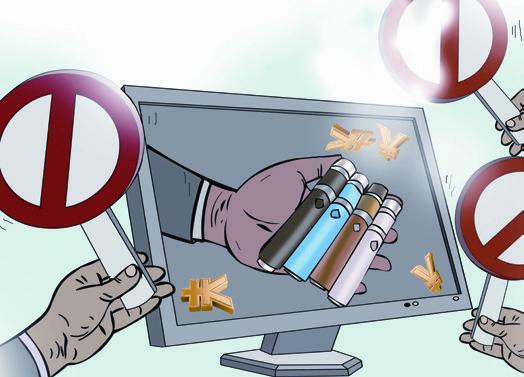A Fork in the Road
2019-11-18ByLiQing
By Li Qing

As many e-business owners hailed surg- ing sales during Chinas November 11 online shopping festival, e-cigarette merchants were forced to watch from the sidelines during the fl urry.
Makers and sellers of e-cigarettes were ordered to shut down their online shops and remove any related online ads, according to a government notice released by the State Tobacco Monopoly Administration and the State Administration for Market Regulation on November 1. Four days later, several Internet companies where e-cigarette products were still available were told to take them down by market regulators in Beijing.
“Our department started to work on product promotion for the shopping festival a month ago, which ended up being for nothing,” Li Guoxing, marketing manager of a medium-sized e-cigarette shop located in Shenzhen in Guangdong Province of south China, told Shanghaibased newspaper China Business News.
Originally, their sales volume was projected to be 3 million yuan ($427,200), 20 percent more than last year. But with the ban, Li had to abandon the hope to meet such a target, since in 2018 online sales accounted for nearly 80 percent of the companys total annual sales and 45.4 percent of their users get their products on the Internet.
E-cigarettes, sometimes called vapes, look like regular cigarettes, cigars or pipes, but they are battery-powered and are used to inhale an aerosol, which contains nicotine, flavors and other chemicals, although some e-cigarettes are nicotinefree.
U.S. e-cigarette manufacturer JUUL Labs attracted international investors and entrepreneurs after posting hefty profits. In 2017, it received $150 million worth of investment. A year later, the company was valued at $38 billion in the market, surpassing the commercial spacecraft giant SpaceX.
However, in China, the largest consumer and producer of tobacco in the world with some 350 million smokers, only 1 percent of users have switched to e-cigarettes, according to the Chinese Center for Disease Control and Prevention(China CDC). Thus, the Chinese market has not been tapped.
In the meantime, China has emerged as the worlds largest producer of e-cigarettes, producing 90 percent of the product worldwide. In 2018, Chinas e-cigarette production exceeded 2.2 billion, and 8,083 applications for related patents were fi led. Meanwhile, the value of the e-cigarette market in China would exceed $800 million in 2019 and is expected to reach $45 billion in 2024, according to data recently released by the China Business Research Institute.
A trouble maker
Jiang Haiyang, a 20-something from Nanjing of Jiangsu Province in east China, bought an e-cigarette via the Internet. He told Beijing Review that he did it out of curiosity because he saw his friends doing it.
“I was told that it could help me quit smoking faster than other methods and that it was less harmful than traditional tobacco,” he said.
However, Xu Wenhui, a doctor at the respiratory department of the Second Hospital of Traditional Chinese Medicine of Jiangsu Province, told Beijing Review that smokers are kidding themselves thinking that e-cigarettes can protect their health.
A U.S. Food and Drug Administration study on e-cigarettes found that in addition to 53 immune genes suppressed by traditional tobacco, e-cigarettes also suppress another 305 immune genes. In addition, the majority of e-cigarettes contain extremely high levels of nicotine, which can lead to addiction.
“They also release many harmful substances, causing respiratory diseases such as chronic bronchitis and even abnormal changes in the lungs,” Xu said.
According to the U.S. Centers for Disease Control and Prevention, in early October, there were 1,299 lung injury cases associated with e-cigarette products in the U.S., with 26 related deaths recorded. The state of Massachusetts has suspended the sale of all e-cigarette products and devices, and New York State has banned the sale of products with scents.
On March 15, the Consumer Rights Day Gala hosted by China Central Television exposed the harm of e-cigarettes and companies using fake information to mislead consumers and exposing them to health hazards. In addition to inferior product quality and irresponsible producers, problems also lay in the absence of relevant standards, quality supervision and safety evaluation in the industry.
According to national regulations, tobacco product packaging must display a warning about the dangers of smoking, and advertising is forbidden. Some companies, ignoring these requirements, adopted diverse approaches to attract young customers.
Shown in candy-colored packages and coming in various flavors such as peach and lychee, e-cigarettes were promoted online by celebrities. There was also a sales strategy to associate it with topics popular among young people such as romance, including videos teaching people how to look cool using the small item.
China CDC revealed that today, 10.35 million Chinese people aged 15 and over use e-cigarettes. Young people aged 15-24 are the group that has the largest proportion vaping, at 1.5 percent. The number of users has been increasing every year.
On November 7, eight administrations, including the National Health Commission(NHC), the Publicity Department of the Communist Party of China Central Committee and the Ministry of Education, issued a notice on further strengthening tobacco control among teenagers. Along with prohibiting the sale of these products online, the notice also committed to elimi-nating tobacco ads in all their forms and teenage access to tobacco.

Some insiders suggested that requesting customers to show ID cards before buying tobacco products should be written into relevant laws in order to eliminate both tobacco and e-cigarette use among teenagers.
The way ahead
Among 195 members of the World Health Organization, e-cigarettes with nicotine have been banned in 30 countries, while 65 others have regulated the products as tobacco or consumer products.
At present in China, e-cigarettes are mainly regulated by local legislation and industry standards. For instance, in Shenzhen in south Chinas Guangdong Province, a major producer of e-cigarettes, the government has regulated the product as tobacco. Meanwhile, the China Electronic Chamber of Commerce has designed two industrial specifi cations for vaporizer products and vaporizer liquid, which took effect in December 2017.
In July, the NHC began researching e-cigarette regulation. According to China Business News, a national standard is under review and is expected to be issued by the end of 2019. All sectors were involved in drafting the professional policy, including China Tobacco Standardization Research Center, Shanghai Tobacco Group Co. Ltd. and the Yunnan Academy of Tobacco Science.
Many insiders regard low entry thresholds and high profits as features of the e-cigarette industry. However, they said that regulation policies will eliminate small and mediumsized enterprises without technological and brand advantages at the same time that some state-owned tobacco companies with competitiveness will enter the fi eld.
“An industry reshuffl e is inevitable, and it has already begun. Many small e-cigarette manufacturers in Shenzhen have been swallowed up by big ones,” Li said.
Xu Xiaoxin, an associate professor at the School of Social Development and Public Policy at Beijing Normal University, told China Daily that the supervision of e-cigarettes can be complicated, and it needs the joint efforts of many administrations.
“E-cigarettes can be regarded as electronic products to a large extent. But they can affect peoples health, which is related to the functions of food and drug administrations and public health departments.,” Xu Xiaoxin explained while calling for inter-departmental cooperation in regulation.
